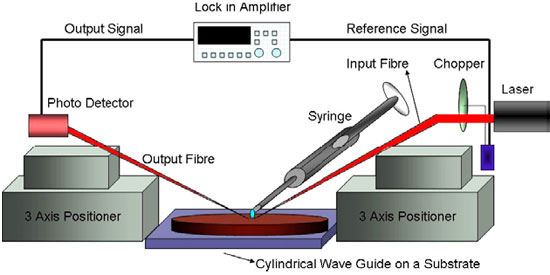| Posted: Aug 17, 2006 | |
Advances in biosensing nanotechnology |
|
| (Nanowerk Spotlight) Researchers have developed a highly sensitive, optical bio-molecule sensor that can distinguish between bio-molecules based on the variation to the light intensity of light due to the change in the path of coupled input light. The variation to the coupled light intensity and path is dependant on the nature of the bio-molecule and the density of the bio-molecules. | |
| As the breadth of biosensor technology (silicon-chip based biomedical diagnostic technologies) continues to expand, there exists a growing need for improving the detection parameters, namely sensitivity, selectivity and speed of detection. | |
| Dr. Shalini Prasad, Assistant Professor in the Department of Electrical and Computer Engineering at Portland State University, explains the background of his group's recent work to Nanowerk: "The biosample–device interface sets operational constraints on the various mechanical, material and preparatory aspects of how samples are collected, processed and applied to the device, as well as on establishing requirements for device biocompatibility. There are numerous approaches to high sensitivity biosensing, and these include a wide range of label-based techniques like fluorescent microarrays, as well as label-free methods such as surface plasmon resonance." | |
| The emphasis on the use of optical micro-cavities for detection constitutes a more recent development. Optical micro-cylindrical micro-cavity based waveguides are structures that enable confinement of light to micro-scale volumes. The principle of operation of these devices is based on coupling light into the micro-cylindrical waveguide and monitoring the optical output signal after multiple reflections of the light beam in the cavity. | |
| Based on recent work, Prasad and her colleagues succeeded in demonstrating the fabrication and operation of a rapidly prototyped optical cylindrical micro-waveguide based biosensor. | |
 | |
| Schematic representation of the instrumentation set-up for the detection of protein bio-molecules. The polymer cylindrical waveguides were excited using a 632.8 nm red laser through an etched silica fibre. The output laser light was extracted through a cleaved fibre. This output light was fed to a silicon photo-detector. The electrical signal from the photo-detector was provided as an input to the lock-in amplifier for synchronous detection with the chopper that modulates the input light. Both the input and the output fibres were mounted on a three-axis mechanical micro-manipulator for precise positioning and alignment. The protein solutions were dispensed using a Hamilton syringe. (Reprinted with permission from IOP Publishing Ltd.) | |
| They report their findings in a recent paper, titled "Micro-photonic cylindrical waveguide based protein biosensor", published in the August 11, 2006 online edition of Nanotechnology. | |
| "We demonstrate that it is possible to use standard micro structures fabricated in non clean room environment to develop a platform based optical sensor that has the potemtial capability in detecting single molecules" says Prasad. | |
| She points out that protein biomarker profiling, that currently requires the use of highly sophisticated and expensive equipment with a long turn around time, can be performed using this new technique with turn around/identification time in minutes. The technique generates specific identifiers for specific proteins, which makes it amenable for multiplexed detection. | |
| According to Prasad, "integration of the source and detection components with the sensors will enable the development of an optical "lab-on-a-chip" device that is capable of detecting bio-molecules that are indicators of specific disease states." | |
| The future research directions in this field, according to Prasad, will be developing integrated sensor systems with multiplexed detection capabilities and integration of surface plasmon resonance capabilities for amplified identification of single molecules. | |
 By
Michael
Berger
– Michael is author of three books by the Royal Society of Chemistry:
Nano-Society: Pushing the Boundaries of Technology,
Nanotechnology: The Future is Tiny, and
Nanoengineering: The Skills and Tools Making Technology Invisible
Copyright ©
Nanowerk LLC
By
Michael
Berger
– Michael is author of three books by the Royal Society of Chemistry:
Nano-Society: Pushing the Boundaries of Technology,
Nanotechnology: The Future is Tiny, and
Nanoengineering: The Skills and Tools Making Technology Invisible
Copyright ©
Nanowerk LLC
|
Become a Spotlight guest author! Join our large and growing group of guest contributors. Have you just published a scientific paper or have other exciting developments to share with the nanotechnology community? Here is how to publish on nanowerk.com.
